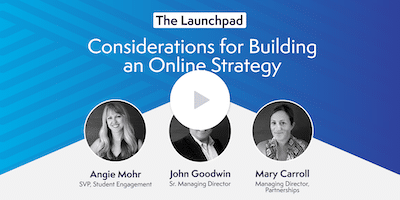Improve Your Marketing Strategy for Student Recruitment
College recruitment strategies have had to adapt rapidly in the past two years. Attracting students requires a completely different approach with today’s always-on digital audience and fewer geographical constraints for online program enrollment.
As we navigate the intense recruitment season, it’s time to take stock of what’s working and what isn’t and explore smarter marketing strategies.
The Importance of Student Recruitment
You’ve been working in higher education for over a decade, but recently, student recruitment seems harder. The good news: You’re not alone. The bad news: Higher-ed enrollment is, in fact, declining. Prospective students are going in less traditional directions and finding cheaper, faster ways to become qualified for the workforce. There are online certifications and boot camps. Inflation isn’t helping either. Simply put, it’s just not as easy as it used to be.
That’s why it’s more important than ever to regroup and refocus. Don’t let the constraints of today’s higher-ed landscape scare you into sticking with outdated ways of reaching prospective students. Instead, rise to the challenge, get a better understanding of the landscape you’re working with, and refresh your enrollment marketing strategy.
3 Student Recruitment Strategies
We won’t tell you that all traditional marketing strategies are outdated, but we do want to make it crystal clear that students are online. They’re surfing the web on their smartphones and discovering new universities and programs through (mostly mobile) online journeys. If your enrollment strategy isn’t rooted in this reality, you’re at risk of losing more than half of your potential students.
1. Meet Them Where They’re At (On Their Phones!)
With 85% of the U.S. residents owning a smartphone, it’s no surprise prospective students are surfing the web from their mobile devices. In fact, a recent report by Oberlo tells us that 58.26% of all internet traffic comes from mobile devices.
Most of the time, however, our web developers, brand managers, and marketing professionals are viewing and building websites on their desktop computers. While working from a computer is convenient, it’s imperative that every single UX/UI change made to your university/program website is tested on both desktop and mobile. Don’t lose out on prospects just because you didn’t consider both website views in your design process. It may seem obvious, but plenty of colleges and universities aren’t considering this important detail.
2. Consider Utilizing Paid Media
Now that you’ve cleaned up your mobile site, you’re ready to start pushing students from other platforms to your program pages through paid media. While paid media isn’t the cheapest option, it’s often one of the most effective. Google Ads, LinkedIn, and Facebook provide fairly straightforward ways to spend for clicks.
We recommend starting with PPC (pay per click) campaigns to attract prospective students to your site. These campaigns help the most with bringing in entirely new audience members whom you may not have been able to reach through organic efforts. The internet is vast, and it’s not always easy to track down potential candidates without some extra help.
After bringing in new prospects from platforms like Google and LinkedIn, your job is to create a journey where they’ll sign up for your newsletter or respond to a survey so you can effectively follow up and make their click worthwhile. It may seem pricey at first, but once the leads start coming in and you’re able to connect with them well after that first click, you’ll see the return on investment.
PPC campaigns can also help speed up the process if you’re finding yourself behind on your goals this quarter.
3. Tap Into Popular Platforms and Their Users
If paid media feels a bit too far out of reach, some high-growth organic options can help attract college students.
Use Instagram to Engage With Students
Most institutions now have a presence on LinkedIn and Facebook, but university marketers may be missing a huge opportunity with Instagram. A recent article from WordStream revealed higher ed’s impressive average engagement rate of 3.19% on Instagram, compared with the median across all industries of 0.98%. Instagram should be used in a completely different way than Facebook and LinkedIn, which can be deterring for content teams, but clearly prospective students are interested in engaging there. Be sure to connect with them and provide tailored content.
Use TikTok to Reach New Audiences
TikTok created a whole new method of engaging with students through its unique short-form video platform. Though the style of content may seem daunting and the editing may seem like a lot of work, Wallaroo Media recently shared that TikTok has 80 million users here in the U.S., with 80% falling into the 16-34 age category. Additionally, 60% are GenZers.
Although prospective student demographics look different across universities, we can confidently say that your target students are likely on TikTok. And more importantly, they’re using it as a source of information. The hashtag #LearnOnTikTok has over 282 billion views, according to FanBytes. It’s not all about sneak peeks of new music or viral dance trends; a large portion of users want to use TikTok to learn. Think of the reasons users visit your website — and the questions they have — and use that insight to inform the kinds of content you can provide to educate prospective students.
Harness the Power of Testimonials
When you hear the words “influencer marketing,” you may think of famous teenagers with millions of followers dancing their hearts out to a 15-second song. While plenty of those influencers are out there, so are users who share their educational journeys, financial tips and tricks, and personal stories about their lives and experiences. With the number of graduates, administrators, and staff members your school has on social media, you’re sure to find some influential users who are willing to share their satisfaction with your program on their channels. It doesn’t require millions of followers either.
Nano influencers (influencers with a following between 1K and 10K) are “everyday people” who come across as more authentic and with much more enthusiasm than the players in the big leagues (micro/macro influencers). The Digital Marketing Institute tells us that 49% of consumers depend on influencer recommendations. That means half of consumers want to read reviews from online personalities they see as trustworthy sources — an amplified version of word-of-mouth marketing.
We Can Help Build Your Marketing Strategy for Student Recruitment
The higher-ed landscape is still undergoing unexpected shifts at a faster rate than most of us are ready for. Some days, you might feel like you’ll be playing catch up for ages, and evolving marketing tactics might make that race feel even harder. It’s a lot to manage, but you don’t have to do it all internally.
At Archer Education, we partner with colleges and universities to create effective messaging that will illuminate your brand’s strengths and unique values to attract and convert high-quality students. Our experts are always in the know, employing tech-enabled, modern enrollment tactics to attract prospective students’ attention, drive engagement, and facilitate action. Don’t overstretch your team members — let us help. Contact us today for more information.



